



Added 11 November 2012
26 September 2012, Buckskin Gulch/Paria Canyon
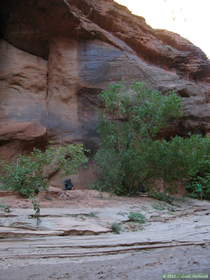
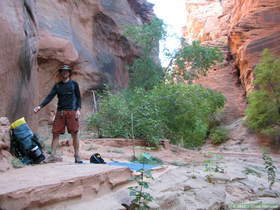 Our plans for the day were not very ambitious in terms of miles, so we weren't in any big rush to get hiking this morning. Hiking through the boulder field between camp and the boulder choke, we encountered a lot of mud, but most of the pools were against one wall or the other so we didn't have as much wading as the previous day.
Our plans for the day were not very ambitious in terms of miles, so we weren't in any big rush to get hiking this morning. Hiking through the boulder field between camp and the boulder choke, we encountered a lot of mud, but most of the pools were against one wall or the other so we didn't have as much wading as the previous day. 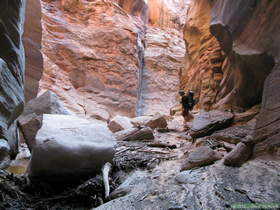
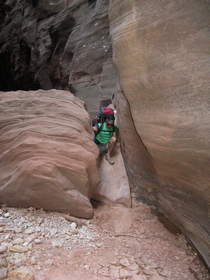
|
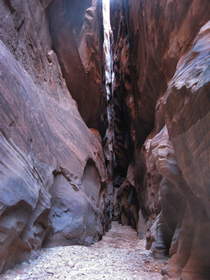
|
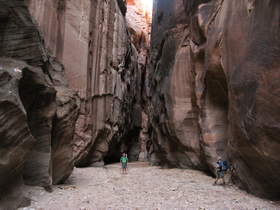
|
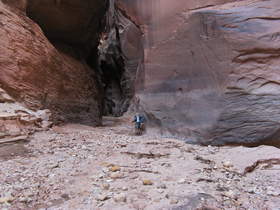
|
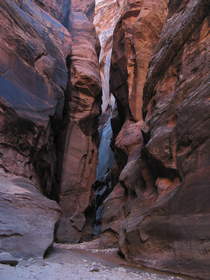
|
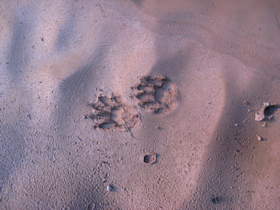
|
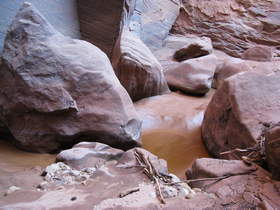 As we hiked down canyon I found a small glossy snake in a mud hole. My first thought was that it must be dead, but Chuck fished it out of the mud with his trekking pole and it was indeed alive. After photographing it, I looked around and it didn't seem like a place that a snake could make a good living.
As we hiked down canyon I found a small glossy snake in a mud hole. My first thought was that it must be dead, but Chuck fished it out of the mud with his trekking pole and it was indeed alive. After photographing it, I looked around and it didn't seem like a place that a snake could make a good living. 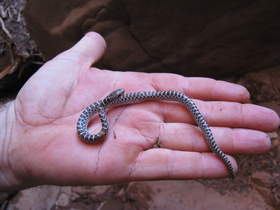 When I hiked Buckskin Gulch in 2004 I found a western patchnose snake (Salvadora hexalepis) that was cold and in a part of the canyon where he would probably never warm up. It was a tough place for a snake to be and I imagined that he had fallen in there and didn't have the energy to get out. Since that day I have always regretted not helping it get to someplace where it had a fighting chance at survival. With that in mind, I picked the glossy snake up and put him in the zippered cargo pocket of my shorts so that I could relocate him to some better habitat. Every time we got to an obstable that required some scrambling I repeated to myself, "Remember the snake in your pocket. Remember the snake in your pocket" to keep myself from accidentally crushing him.
When I hiked Buckskin Gulch in 2004 I found a western patchnose snake (Salvadora hexalepis) that was cold and in a part of the canyon where he would probably never warm up. It was a tough place for a snake to be and I imagined that he had fallen in there and didn't have the energy to get out. Since that day I have always regretted not helping it get to someplace where it had a fighting chance at survival. With that in mind, I picked the glossy snake up and put him in the zippered cargo pocket of my shorts so that I could relocate him to some better habitat. Every time we got to an obstable that required some scrambling I repeated to myself, "Remember the snake in your pocket. Remember the snake in your pocket" to keep myself from accidentally crushing him.
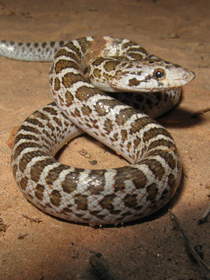
|
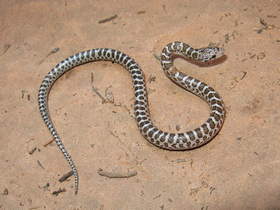
|
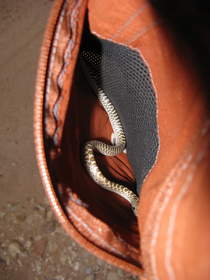
|
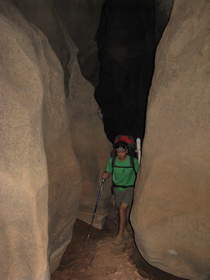
|
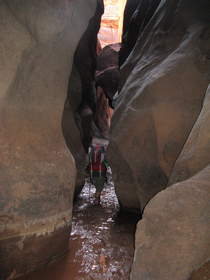
|
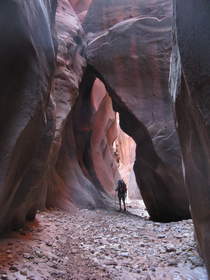
|
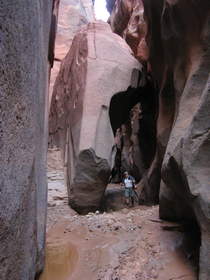
|
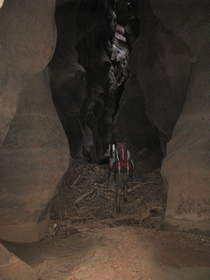
|
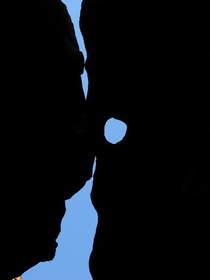
|
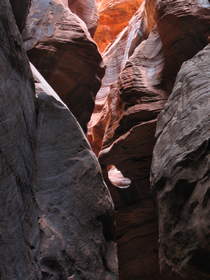
|
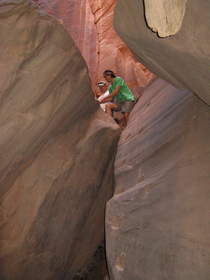 We arrived at famous boulder choke just as three people from downstream did.
We arrived at famous boulder choke just as three people from downstream did. 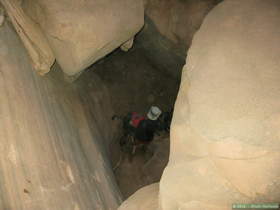 We chatted for a bit then they stayed to watch us descend before heading back downstream. I went down first, then Steve lowered all of the packs down to me. Chuck descended next. He was nervous all along about rope descent off the boulder choke, but he did fine. Steve came down last, and we continued on our merry way.
We chatted for a bit then they stayed to watch us descend before heading back downstream. I went down first, then Steve lowered all of the packs down to me. Chuck descended next. He was nervous all along about rope descent off the boulder choke, but he did fine. Steve came down last, and we continued on our merry way. 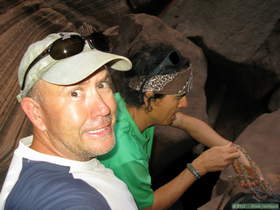
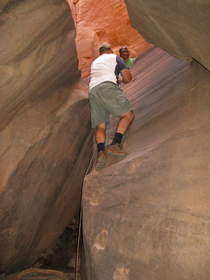
|
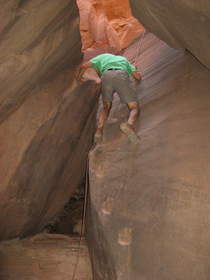
|

|
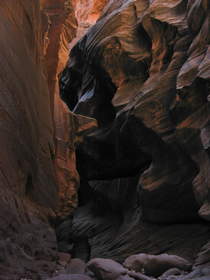
|
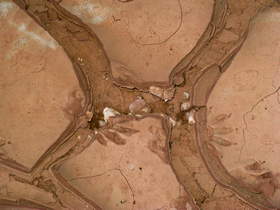
|
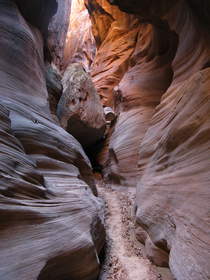
|
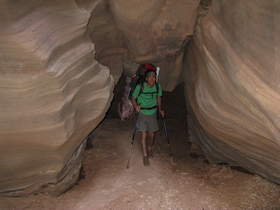
|
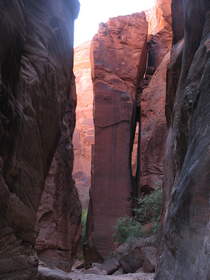
|
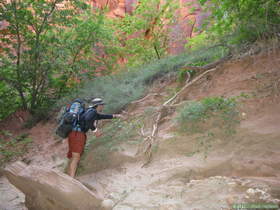
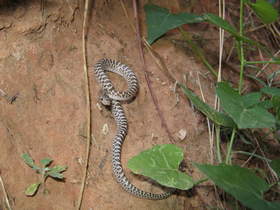 Eventually we found a spot with a nice terrace that we thought would make an excellent new home for the glossy snake in my pocket, so I pulled him out and placed him in the vegetation up on high ground. He eyed me warily, then I wished him luck and let him be.
Eventually we found a spot with a nice terrace that we thought would make an excellent new home for the glossy snake in my pocket, so I pulled him out and placed him in the vegetation up on high ground. He eyed me warily, then I wished him luck and let him be.
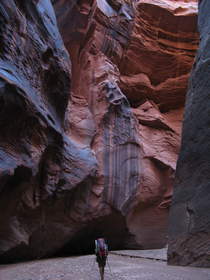
|
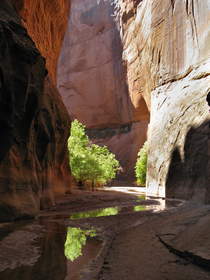
|
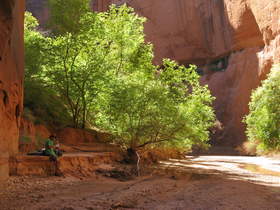
|
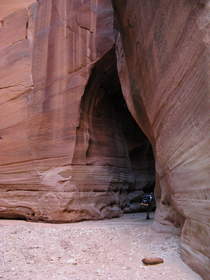
|
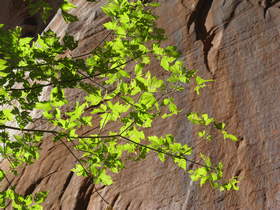
|
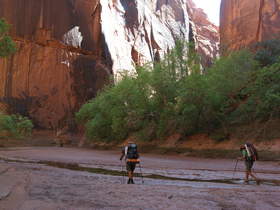
|
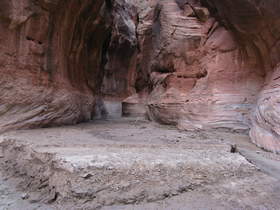
|
We encountered some more hikers doing a day trip up Buckskin who said that the flow in Paria had just doubled about an hour ago. Very interesting. 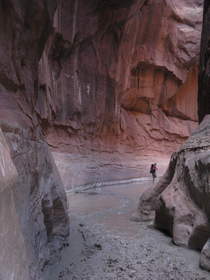 Apparently some part of the watershed got a lot more rain than we did. The woman was also definitely playing up how many people she had seen down at their camp at Big Spring. All three of us got the distinct impression she was trying to scare us away from camping near them.
Apparently some part of the watershed got a lot more rain than we did. The woman was also definitely playing up how many people she had seen down at their camp at Big Spring. All three of us got the distinct impression she was trying to scare us away from camping near them.
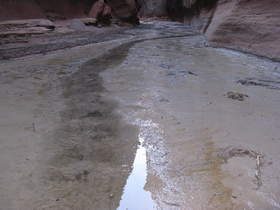 As we approached the confluence we hit the semi-permanent water flow down the canyon. It was only about an inch deep. As we got to within a few hundred meters of the confluence we encountered slightly deeper but far less clean water flowering down Buckskin. It had the smell of the second odiferous pool from the first day. It smelled like decaying juniper debris. It was only about ankle deep, but walking through it was mildly unsettling for some reason.
As we approached the confluence we hit the semi-permanent water flow down the canyon. It was only about an inch deep. As we got to within a few hundred meters of the confluence we encountered slightly deeper but far less clean water flowering down Buckskin. It had the smell of the second odiferous pool from the first day. It smelled like decaying juniper debris. It was only about ankle deep, but walking through it was mildly unsettling for some reason.
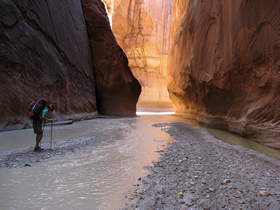
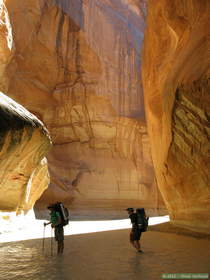 When we stepped out into the confluence of Buckskin Gulch and Paria Canyon I nearly went in to shock. I had passed the campsite Shannon, Jeff and I stayed at in 2004 without even seeing it. I didn't see it because it wasn't even there! At that time, there were about 9 people camping at the confluence.
When we stepped out into the confluence of Buckskin Gulch and Paria Canyon I nearly went in to shock. I had passed the campsite Shannon, Jeff and I stayed at in 2004 without even seeing it. I didn't see it because it wasn't even there! At that time, there were about 9 people camping at the confluence. 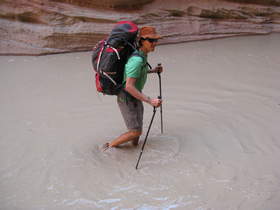 Now, there wasn't even a spot for one person to camp. And then there was the Paria itself. I remembered the Paria being a clear little stream flowing over sands and gravels through a mostly gravel lined overbank. This time the river was an opaque gray-brown soup and the overbank was completely covered in mud. So much for getting cleaned up when getting to Paria . . .
Now, there wasn't even a spot for one person to camp. And then there was the Paria itself. I remembered the Paria being a clear little stream flowing over sands and gravels through a mostly gravel lined overbank. This time the river was an opaque gray-brown soup and the overbank was completely covered in mud. So much for getting cleaned up when getting to Paria . . .
It was immediately clear that the bottom several feet of the canyon was significantly changed from my previous visit. The changes were exciting to witness and, I have to admit, also somewhat disappointing. The flooding through Buckskin Gulch didn't really change the character of the canyon at all, and actually rather enhanced it. The flooding through Paria certainly did change the character of the canyon. As we walked down canyon to find a campsite, I could see fairly big changes. I couldn't even find one feature which was a sort of arch formed I believe by part of the canyon wall separating from the rest of the sandstone. 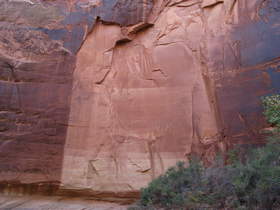 I assume that it got packed with sediment and was simply unrecognizable to me at the time. A lot of vegetation was wiped out right in the bottom of the canyon, but the larger benches were still intact (if slightly reduced in size) and were largely unaffected. The biggest change, or rather the change that most affected me, was definitely the mud coated streambed though. The streambed was such a beautiful collection of rocks and gravels of all different rock types and colors. In the end, I had to admit that the canyon was still pretty as hell, it just wasn't quite as idyllic as it had been.
I assume that it got packed with sediment and was simply unrecognizable to me at the time. A lot of vegetation was wiped out right in the bottom of the canyon, but the larger benches were still intact (if slightly reduced in size) and were largely unaffected. The biggest change, or rather the change that most affected me, was definitely the mud coated streambed though. The streambed was such a beautiful collection of rocks and gravels of all different rock types and colors. In the end, I had to admit that the canyon was still pretty as hell, it just wasn't quite as idyllic as it had been.
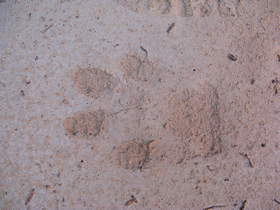 Chuck wanted to find a place pretty close to the confluence so that we wouldn't have a long hike out on Friday, so we found a spot about a half a mile down canyon. It was nice and flat, but the sun was baking it and there weren't any trees for shade, so Steve and I wandered around another bend to make sure we weren't just a little bit shy of someplace much nicer.
Chuck wanted to find a place pretty close to the confluence so that we wouldn't have a long hike out on Friday, so we found a spot about a half a mile down canyon. It was nice and flat, but the sun was baking it and there weren't any trees for shade, so Steve and I wandered around another bend to make sure we weren't just a little bit shy of someplace much nicer.
I'm glad we did, because we found a nice large bench with a neat alcove above it. Due to the bend of the canyon, we figured it would get far less sun, and I suspected that the alcove would never see the sun. 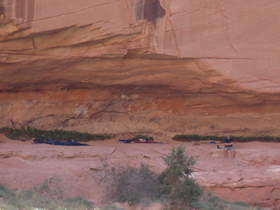 We went back to get Chuck and collect our packs. As we walked up to our camping area for the first time with Chuck, Steve, who was last in line, leapt to the side of the trail. Chuck and I looked at him with a "what just happened" kind of look, I suspect both of us were jokingly thinking that maybe he got attacked by another tarantula hawk wasp. This time he had more reason to jump though. We had gotten the attention of a Great Basin Rattlesnake (Crotalus oreganus lutosus). Chuck used his trekking pole to relocate him to the bottom of a nearby ravine and we milled around to establish our respective camping areas. Steve and Chuck set up at the base of the canyon wall so I set up camp in the alcove.
We went back to get Chuck and collect our packs. As we walked up to our camping area for the first time with Chuck, Steve, who was last in line, leapt to the side of the trail. Chuck and I looked at him with a "what just happened" kind of look, I suspect both of us were jokingly thinking that maybe he got attacked by another tarantula hawk wasp. This time he had more reason to jump though. We had gotten the attention of a Great Basin Rattlesnake (Crotalus oreganus lutosus). Chuck used his trekking pole to relocate him to the bottom of a nearby ravine and we milled around to establish our respective camping areas. Steve and Chuck set up at the base of the canyon wall so I set up camp in the alcove.
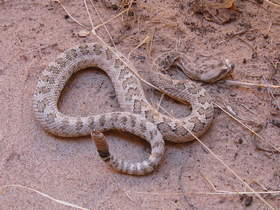
|
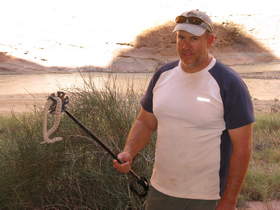
|
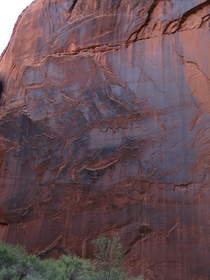
|
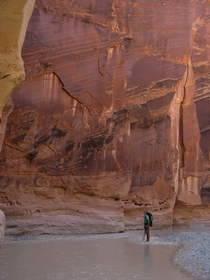
|
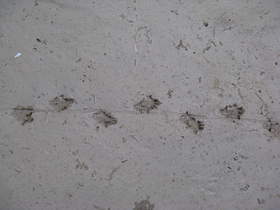
|
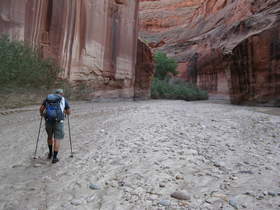
|
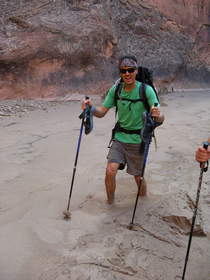 Once we had set up camp, we gathered up our filters and water containers to hike down canyon to filter water. The Paria was such a silty mess that we really didn't want to punish our filters by trying to get water from it.
Once we had set up camp, we gathered up our filters and water containers to hike down canyon to filter water. The Paria was such a silty mess that we really didn't want to punish our filters by trying to get water from it. 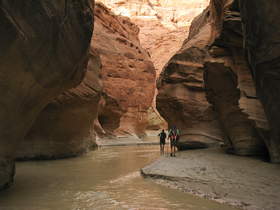 As we hiked down canyon, I stepped down off of a dry sandy bench onto what appeared to be firm ground and immediately sunk above mid-calf. I knew something was wrong the instant my foot touched the surface so by the time my foot hit something slightly solid I was already jumping to get out of the quicksand I had just stepped into. On my second step I sunk a few inches above my ankle and by the third step I was clear. I turned around and there was only the slightest hint of a depression where I had sunk in. And the surface still looked solid. That was the first time I had ever experienced quicksand. It was rather exhilarating, I must say. I might have been frightened if I hadn't known that quick sand is rarely more than thigh deep and hardly ever deep enough to actually be deadly.
As we hiked down canyon, I stepped down off of a dry sandy bench onto what appeared to be firm ground and immediately sunk above mid-calf. I knew something was wrong the instant my foot touched the surface so by the time my foot hit something slightly solid I was already jumping to get out of the quicksand I had just stepped into. On my second step I sunk a few inches above my ankle and by the third step I was clear. I turned around and there was only the slightest hint of a depression where I had sunk in. And the surface still looked solid. That was the first time I had ever experienced quicksand. It was rather exhilarating, I must say. I might have been frightened if I hadn't known that quick sand is rarely more than thigh deep and hardly ever deep enough to actually be deadly.

|
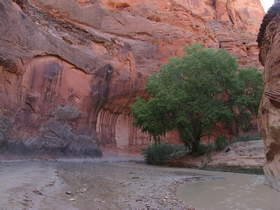
|
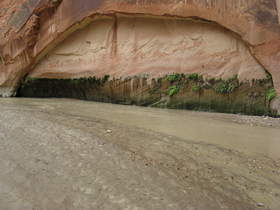
|
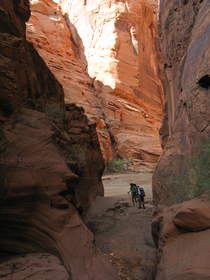
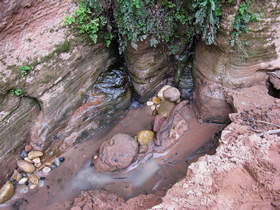 The first spring we came to (Wall Spring) wasn't much more than a concentrated bunch of drips from an overhanging wall, so we decided to head down canyon to find a better source. The next spring had a solid, clean flow, but had been buried in flood-borne sediment and there wasn't an especially easy way to filter out of it. Our option was to hike another two miles down canyon to Big Spring though, so we decided to make some improvements to this one and make it work.
The first spring we came to (Wall Spring) wasn't much more than a concentrated bunch of drips from an overhanging wall, so we decided to head down canyon to find a better source. The next spring had a solid, clean flow, but had been buried in flood-borne sediment and there wasn't an especially easy way to filter out of it. Our option was to hike another two miles down canyon to Big Spring though, so we decided to make some improvements to this one and make it work.
I started in to work on cleaning the sand and muck out away from the source of the spring, using only my hands as shovels. It became quickly apparent that another spring up the side canyon was carrying sand into our spring at a surprisingly good clip for such a small flow. I realized that I was going to have to segregate the flows coming from the two sources so that I could keep the sand flowing down the one source out of the cleaner source. 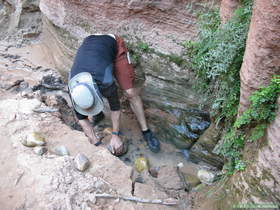 I built a little levy of rocks and sticks, then excavated a small pool on the clean side and lined it with rocks so that our filters wouldn't get completely clogged.
I built a little levy of rocks and sticks, then excavated a small pool on the clean side and lined it with rocks so that our filters wouldn't get completely clogged.
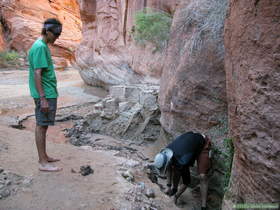 Three new problems immediately surfaced. Even with the rocks in the bottom of it, the act of filtering was stirring up a lot of sediment in the cleaner pool. Also, the only place to sit to filter water was a very unstable sand bank next to the spring which was likely to collapse and completely bury the spring, and even that was barely within range of the spring with the length of hose for our filters. The biggest problem was that sand was quickly building up on the dirty side of the levy, and without near constant maintenance, would quickly overtop the levy and dump sand into our clean pool.
Three new problems immediately surfaced. Even with the rocks in the bottom of it, the act of filtering was stirring up a lot of sediment in the cleaner pool. Also, the only place to sit to filter water was a very unstable sand bank next to the spring which was likely to collapse and completely bury the spring, and even that was barely within range of the spring with the length of hose for our filters. The biggest problem was that sand was quickly building up on the dirty side of the levy, and without near constant maintenance, would quickly overtop the levy and dump sand into our clean pool.
What I ended up doing was deepening the clean pool so that I could get my camp sink into it. I filled up my camp sink with as much water as I could then handed it off to the guys. While they filtered water, I dug sand out from the front side of the levy to keep the sand from overtopping it. That process also included excavating sand from further downstream to keep the sand in the upper part moving downstream. I was really putting my professional knowledge of fluvial processes to work! I was also putting a lot of my muscles to work. I was constantly active maintaining the spring so we could start with reasonably clean water.
So while I was doing all of this, Steve was filtering water, and Chuck was mostly screwing around with his inoperable filter. I couldn't filter myself because I was too busy with the sand, so I offered my filter to Chuck so that he could speed up the process. He was determined to get his filter working though, and kept at it until he did. As a result, Steve filtered water for the two of us before Chuck was done filtering water for just himself. This was definitely the most work I've ever done to get water, and I wasn't even filtering!
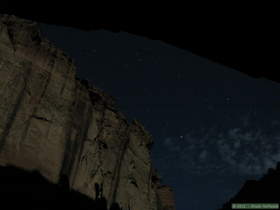 With enough water to last us for the next couple of days in our packs, we headed back to camp. As we hiked some moderately ominous looking clouds had formed overhead. Since, like me, Chuck did not have a tent, once we got back to camp he moved his camp to the alcove near me in case it started to rain. We spent the evening hanging out in the alcove having dinner and talking. When the moon came up it created a shadow play on the canyon wall opposite our alcove. As we talked about other things, we would also comment about the changing scene on the wall, which Chuck got a kick out of taking pictures of. By this time most of the clouds had gone away and it was a beautiful night.
With enough water to last us for the next couple of days in our packs, we headed back to camp. As we hiked some moderately ominous looking clouds had formed overhead. Since, like me, Chuck did not have a tent, once we got back to camp he moved his camp to the alcove near me in case it started to rain. We spent the evening hanging out in the alcove having dinner and talking. When the moon came up it created a shadow play on the canyon wall opposite our alcove. As we talked about other things, we would also comment about the changing scene on the wall, which Chuck got a kick out of taking pictures of. By this time most of the clouds had gone away and it was a beautiful night.
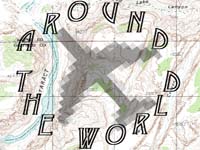 |
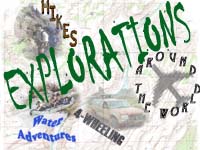 |